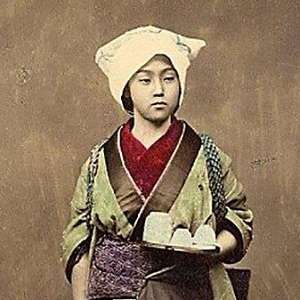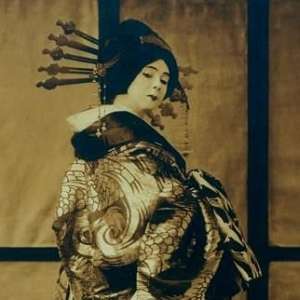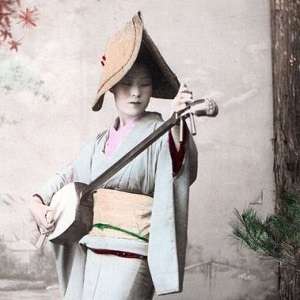In a quiet corner of Nanto City, Toyama Prefecture, stands a humble mound known as Osayo-zuka.
This memorial was built in honor of a young woman named Osayo, who met a tragic and untimely end.
Who was Osayo?
What kind of life did she lead—and how did it come to such a sorrowful conclusion?
Today, we trace the footsteps of Osayo’s life, a heartbreaking story that has endured across generations.
(Note: Historical details about Osayo, including her exact dates of birth and death, vary across sources.)
Sold into the Pleasure Quarters of Kanazawa

Image: Osayo as a young girl – conceptual
Osayo was born in 1670 (Kanbun 10) in a small farming village called Kuresaka, located in what is now Wajima City, Ishikawa Prefecture.
At the age of 13, in 1682 (Tenwa 2), she was sent to work at a Mugiya—a noodle shop specializing in somen, a local specialty.
Osayo labored diligently and faithfully for several years.
When her indentured term ended, she returned home to Kuresaka, likely around 1688 (Genroku 1).
However, her joyful reunion with her family was short-lived.
Before long, Osayo was sold to a pleasure quarter in the city of Kanazawa.
The reasons are unclear—perhaps economic hardship forced her family’s hand, or perhaps she fell victim to unscrupulous brokers known as zegen, who often lured young girls with promises of prosperous marriages or good employment.
In any case, Osayo was taken away, thrust into a life she had never chosen.
A Brief Rise in the Pleasure Quarters

Image: Osayo working as a courtesan – conceptual
Kanazawa, famous for its refined chaya (teahouse) culture even today, once thrived with bustling pleasure districts.
There, Osayo became a yujo—a courtesan.
Despite the cruelty of her fate, Osayo quickly distinguished herself.
Gifted and graceful, she mastered singing, shamisen, dancing, and drumming, becoming popular among the patrons.
But fate struck again.
In 1690 (Genroku 3), the brothel where Osayo worked was exposed for illegal operations, and the entire establishment was shut down.
Everyone involved—including the courtesans—was sentenced to exile as punishment.
Though Osayo had not chosen her path, she was dragged into collective guilt.
Worse yet, because her hometown was close to the assigned place of exile (Noto), officials deemed it inappropriate for her to return near home, and ordered her exiled elsewhere—alone.
Thus, Osayo was separated from her fellow courtesans and sent by herself into the remote mountains of Gokayama, in present-day Toyama Prefecture.
Betrayed by Love and a Tragic End

Image: Osayo showcasing her arts – conceptual
At just 21 years old, branded as a criminal, Osayo began a harsh new life in the isolated mountains.
The local villagers sympathized with her plight and treated her kindly.
In gratitude, Osayo occasionally shared her talents—songs, dances, and other arts learned during her courtesan days.
In time, she fell in love with a young man from a neighboring village, a youth named Kichima.
Despite her stained status, their relationship blossomed, and Osayo eventually became pregnant.
Yet when faced with the reality of marriage, Kichima recoiled.
Perhaps pressured by his family, or by fear for his family’s reputation, he abandoned her, saying:
“No matter how kind or beautiful you are… I cannot marry a criminal.”
Heartbroken, Osayo realized that even love could not wash away the stigma attached to her.
Fearing the shame and suffering her unborn child would face as the offspring of an outcast, she made a final, desperate choice.
In 1697 (Genroku 10), at the age of 28, Osayo threw herself into the waters of the Shogawa River, ending her life.
Timeline of Osayo’s Life
・1670 (Kanbun 10): Born in Kuresaka Village.
・1682 (Tenwa 2): Sent to work at a Mugiya.
・~1688 (Genroku 1): Returns home after completing her service.
・Date unknown: Sold to a Kanazawa pleasure quarter.
・1690 (Genroku 3): Exiled to Gokayama after brothel scandal.
・Date unknown: Falls in love with Kichima.
・Date unknown: Pregnant, but rejected by Kichima.
・1697 (Genroku 10): Commits suicide by drowning at age 28.
Conclusion
The story of Osayo is one of relentless misfortune, culminating in a tragic end.
Different versions of her tale survive—some varying in birthplace, dates, or details—evidence of how her life evolved into legend over time.
Regardless of the variations, one hope endures:
That somewhere beyond this world, Osayo has found the peace and happiness that eluded her in life.
References:
Osayo-zuka – Ikomaike Nanto
Osayo-zuka – Toyama Tourism Navi
Osayo-zuka – Nihon Densho Taikan (Encyclopedia of Japanese Legends)


